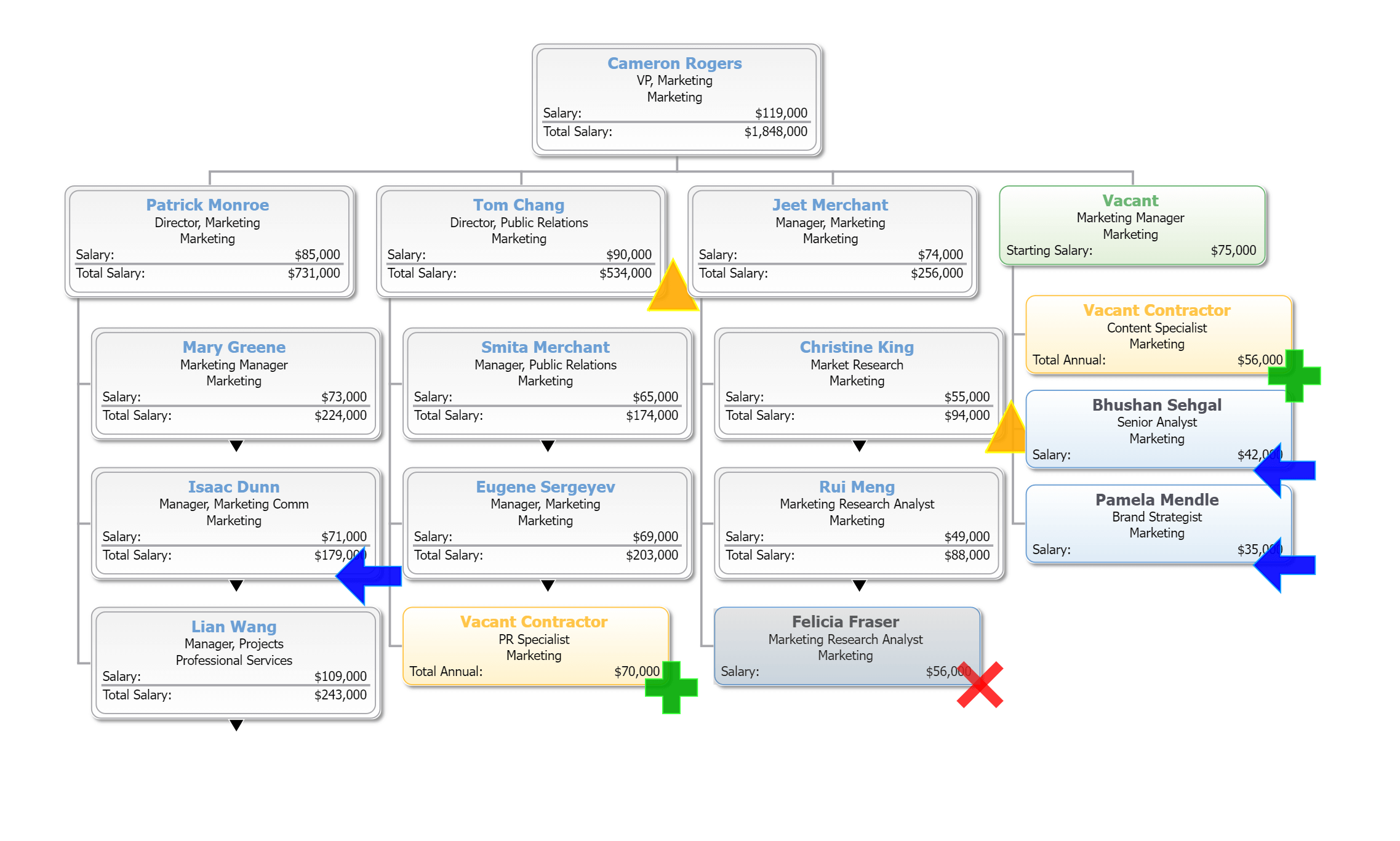Gone are the days where HR departments are simply known for maintaining compliance. Instead, they now play a pivotal role in ensuring organizational success by effectively managing employees, making strategic decisions, and creating employee-centric programming.
One strategy companies use to help elevate their HR teams is investing in human resources planning tools. Below we explain ins and outs of HR software, including benefits and how to execute a thoughtful implementation process.
Understanding HR Planning Software
HR planning software is a sophisticated solution tailored to streamline and enhance HR processes, from recruitment to talent management and beyond.
At its core, HR planning software serves as a comprehensive platform designed to optimize workforce planning and management. Its functionalities encompass a wide array of tasks, including but not limited to:
- Recruitment and Onboarding: HR planning software facilitates the entire recruitment cycle, from job posting and applicant tracking to interview scheduling and onboarding processes. It centralizes candidate data, expedites hiring decisions, and ensures a seamless transition for new hires into the organization.
- Performance Management: Traditional performance management methods often involve cumbersome paperwork and manual evaluations. HR planning software automates performance management processes, allowing for continuous feedback, performance tracking, and equitable processes across teams. This feature promotes transparency and accountability while enabling timely interventions to enhance employee productivity and development.
- Training and Development: Employee skill development is vital for organizational growth and competitiveness. Luckily, HR strategy software offers functionalities to identify skill gaps, create personalized training plans, and track training progress. By facilitating continuous learning opportunities, companies can foster a culture of innovation and professional growth within their workforce.
Succession Planning: Anticipating and preparing for future talent needs is crucial for organizational resilience. HR planning software enables HR professionals to identify high-potential employees, assess their readiness for key roles, and implement succession plans to mitigate leadership gaps and ensure business continuity.

Compared to traditional HR management approaches, which often rely heavily on manual processes and disparate systems, HR planning software offers several distinct advantages, including:
- Efficiency and Automation: By automating routine HR tasks and centralizing data in a unified platform, HR planning software significantly reduces administrative burdens and minimizes the risk of errors associated with manual data entry.
- Data-Driven Decision-Making: With robust analytics and reporting capabilities, HR planning software empowers HR professionals to derive actionable insights from vast amounts of workforce data. That’s because workforce planning solutions enable informed decision-making aligned with organizational goals and objectives.
- Enhanced Collaboration and Communication: Modern HR planning software often includes collaboration features that facilitate seamless communication and knowledge sharing among HR teams, managers, and employees. This fosters a culture of transparency and collaboration across the organization.
- Scalability and Adaptability: As organizations evolve and grow, their HR needs change as well. HR planning software offers scalability and flexibility to accommodate changing requirements, whether it’s expanding workforce size, entering new markets, or adapting to industry shifts.
Realizing the Benefits of HR Planning Software
The benefits of using HR planning software with people analytics capabilities are substantial. In short, organizations that embrace data-driven strategies often experience streamlined operations, improved talent management, and increased overall performance.
Below are three examples illustrating the impact of workforce planning solutions:
Reduced Turnover
Software Company X noticed a consistently high turnover rate among its marketing department. After diving into their employee data, they discovered that many of the departing employees had common concerns related to a lack of career advancement opportunities and workplace satisfaction. Armed with this insight, HR implemented measures to improve career growth prospects within the department, including mentorship programs, skill development workshops, and performance recognition initiatives. As a result, they observed a significant decrease in turnover rates, saving the organization substantial recruitment and onboarding costs.
Optimized Recruitment
Retail Chain Y had been allocating considerable resources to various recruitment channels (such as job boards, social media, and employee referrals) without a clear understanding of which channels yielded the best candidates. HR strategy software with people analytics capabilities was introduced to analyze the effectiveness of each channel. The data revealed that employee referrals consistently led to higher-quality hires. As a result, the HR team shifted their recruitment strategy to prioritize employee referrals, reducing both time-to-fill and recruitment costs while also enhancing the overall quality of new hires.
Succession Planning
Manufacturing Company Z recognized the need to identify and nurture potential future leaders within the organization. They looked at their company org chart to view their employees’ performance, skills, and career trajectories. This analysis unveiled several promising individuals with strong leadership potential. With this data-driven insight, HR implemented a structured leadership development program, providing these high-potential employees with specialized training and mentoring opportunities. Over time, several of these individuals transitioned into key leadership roles, ensuring a seamless succession plan and safeguarding the company’s long-term success.
Implementing HR Planning Software
Purchasing and implementing HR planning software is a strategic endeavor that requires careful planning, effective execution, and strong collaboration across departments.
For a successful implementation process, make sure you follow these seven steps.
- Needs Assessment: Begin by conducting a thorough assessment of your organization’s HR requirements, processes, and challenges. Identify pain points and areas for improvement so you can pinpoint which software functionalities are non-negotiables. Engage key stakeholders, including HR professionals, department heads, and IT personnel, to ensure alignment with organizational objectives.
- Vendor Selection: Choose a reputable vendor that offers HR planning software tailored to your organization’s needs. Evaluate vendors based on factors such as functionality, scalability, user-friendliness, customer support, and cost. Request demos, speak with references, and consider factors like data security and compliance before making a decision.
- Data Migration and System Integration: Determine the data you need to migrate from existing HR systems and ensure compatibility with the new HR planning software. Develop a comprehensive data migration plan to minimize disruption and ensure data accuracy. Additionally, assess integration requirements with other systems such as payroll, timekeeping, and ERP to streamline processes and data flow.
- Training and Onboarding: Provide comprehensive training and onboarding programs for HR teams and end-users to ensure they are proficient in using the new HR planning software. Training should cover system navigation, data entry, reporting, and best practices for maximizing the software’s capabilities. Offer ongoing support and resources to address any questions or challenges that may arise during the transition period.
- Pilot Testing: Before rolling out your HR planning software organization-wide, conduct pilot testing with a small group of users to identify potential issues and gather feedback for refinement. Use this opportunity to fine-tune configurations, address any technical issues, and validate the software’s effectiveness in real-world scenarios.
- Phased Implementation: Implement the HR planning software in phases to manage risk and minimize disruption to daily operations. Start with core functionalities such as recruitment and onboarding before gradually expanding to other modules like performance management and succession planning. Monitor progress closely and make adjustments as needed to ensure a smooth transition.
- Change Management: Implementing new software often involves changes to established workflows and processes. Implement a change management plan to communicate the benefits of the HR planning software, address concerns, and solicit feedback from stakeholders. Foster a culture of openness to encourage adoption and minimize resistance to change.
By following these steps, organizations can successfully implement HR planning software to streamline HR processes, enhance decision-making, and unlock the full potential of their workforce management strategies.
Trusted By Thousands to Chart Millions
HR planning software represents a paradigm shift in HR management, offering a holistic approach to workforce planning and management. By leveraging automation, analytics, and collaboration tools, HR strategy software empowers organizations to optimize their human capital management strategies and drive sustainable business success.
If you’re looking for HR software, OrgChart is the right choice. With it, HR teams can visualize their current and future states, allowing leaders to strategize and make the right decisions for their organization. Moreover, automation and collaboration features save teams time so they can spend more time strategizing instead of wrangling data.

-
“It’s great for seeing our entire organization in a few clicks.”
Jason G.,
Enterprise (> 1000 emp.)
-
“Extremely easy to implement and use. Easy and fast to create charts, allowing the information to be always updated and even better, customised.”
Carolina F.,
Sales Operations Lead
-
“OrgChart creates a perfect org chart that’s easy to update every time. Saves battling with MS Visio every time there a staffing change.”
Leo C.,
Managing Director Mid-Market (51-1000 emp.)
-
“Connects directly to our HRIS and updates on a normal cadence — we choose daily. You can also update as needed. Took several hours a month of org chart planning off of our plates … the ROI in terms of time spent is fantastic.”
Verified User in Pharmaceuticals,
Mid-Market (51-1000 emp.)
-
“Amazingly easy to implement. Easy and fast to create charts, allowing the information to be always updated and even better, customized.”
Carolina F.,
Small Business
-
“OrgChart is taking our very manual org chart creation and making it easier to make changes. We were also able to easily add the new photos we took of all employees.”
Jacqueline W.,
Mid-Market (51-1000 emp.)
-
“The only comprehensive Org Chart software! Easy to set up templates, upload information, and build comprehensive charts. We have used the software to understand the span of control and ultimately organizational design.”
Jillian P.,
Head of Talent Acquisition & Onboarding Mid-Market (51-1000 emp.)





